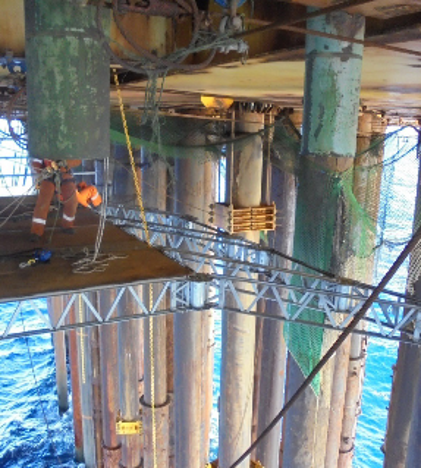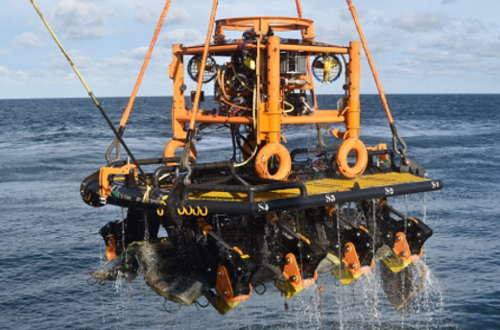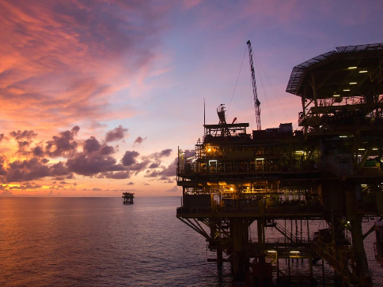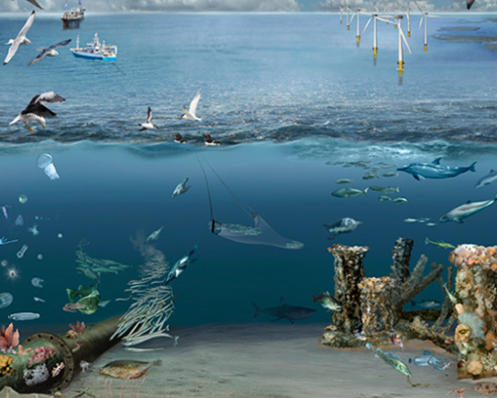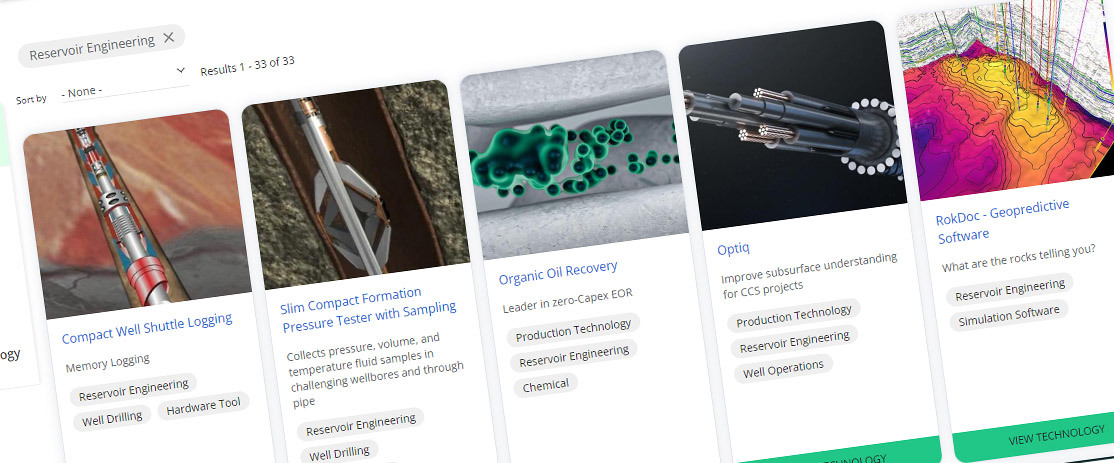
Only a few Operators (8 out of 55) are reporting in this category but for those that do they include:
Access systems, such as walk to work and modular deck extensions to increase deck space and ‘energy pods’ for lighthouse mode using renewables.
Cost-efficient external flotation systems to float and tow jackets and topsides to shore for disposal.
Shaped charges to cut subsea tie-rods, topsides deployed ROVs to remove conductor anodes, and diver-less riser/pipeline separation by ROV.
Growing use of digital solutions, including for predictive decommissioning modelling, scheduling and optimisation.
- Operators’ technology focus spreads across the entire Decommissioning cycle
- It encompasses asset late-life management, work planning, topsides removal and subsea decommissioning
- There are only 8 Operators in total reporting technologies in this area
As Decommissioning is a relatively new field, at least on the scope and scale it has recently reached in the UKCS, it is not surprising to see that
Operators are targeting innovative and less than fully proven technologies (over 50% of the entries) Operators seek to participate in decommissioning technology development and adoption, complementing the vendors efforts (circa 40% of technologies)
Readiness definitions: Early Development (TRL 1-4), Late Development/Pilot (TRL 5-7), Early commercialisation (TRL 8), Proven (TRL 9)
Operator focus is on alternative power generation technologies and peak load management to reduce emissions during late life and decommissioning phases, access systems such as walk to work to allow decommissioning personnel to have accommodation in the field without adding to platform headcount and modular deck extensions to increase deckspace for well P&A and decommissioning.
- Walk to work - SMST modular gangway technology delivered ~ 90% uptime of fully connected gangway from CSV to platform when separating Ninian Northern topsides and jacket. Believed to be most Northerly application of walk to work.
- TRL 9 Proven Technologies
- Peak load management - Emissions Reduction - Utilising load bank and battery technology to manage peak load and reduce need for higher diesel generation requirements
- TRL 9 Proven Technologies
- Modular Deck Extensions - Expansion of Topside Deck Space to better perform Well P&A and Decom activities (avoid requirement for a TSV)
- TRL 9 Proven Technologies
|
Technology Example: Modular Deck - Today’s highly competitive construction and maintenance programs demand bespoke methods of access that deliver the optimum levels of safety and efficiency. QuikDeck® can be built in the air, or on the ground and then hoisted into location |
Link: TI 22 – 65. Technology example – Aquaterra QUIKDECK Modular Deck Extension - Copy.docx |
- On/Offshore Collaboration Room - Facility to draw together on and offshore teams in a shared virtual working space
- TRL 9 Proven Technologies
- Novel subsea tooling suite - Development of bespoke tooling suite through specialist contractor.
- TRL 8 Early Commercialisation
- Alternative power generation - Specialised vendor to use alterative methods for power generation during and after platform habitation.
- TRL 8 Early Commercialisation
- Variable buoyancy system for subsea operations - Use of variable buoyancy system to deploy tooling at significant excursion from marine crane (alternative to air bags).
- TRL 5-7 Late Development/Pilot
Innovations include re-usable modular grillages, modular access platforms and cutting technologies from well abandonment deployed for topsides dismantling. Emerging technologies include using external flotation systems to float off and tow jackets and topsides to shore for disposal. New this year are transportable energy pods for lighthouse mode powered by renewable sources only, and two-part conductor removals on GBS structures.
- Reusable modular grillages - The re-usable modular grillage solution contributes to reducing greenhouse gases by being re-usable and scalable due to less steel required to be produced for bespoke systems as well as opening availability to more UK ports ? removing the logistic requirements to use ports overseas.
- TRL 9 Proven Technologies
- QuikDeck Access - AquaTerra - Modular Alternative access systems, gives increased deck space for Decommissioning and well P&A activities (See 2. late life Management & Equipment Readiness)
- TRL 8 Early commercialisation
- Control Cutter for Conductor recovery - Decom tool to shear multiple string casings at surface ,rather than traditional methods
- TRL 8 Early Commercialisation
- Energy POD - Transportable, autonomous energy container combining wind turbine, solar panels and battery storage for use on platforms in lighthouse mode
- TRL 8 Early Commercialisation
- TRL 8 Early Commercialisation
- Conductor removals – Two Part Conductor removals for GBS structures - conductors will be separated at the +6m level and the upper sections will be recovered with the topsides single lift, the free-standing lower sections below +6m will be recovered from a construction vessel after the topsides single lift.“
- TRL 8 Early Commercialisation
- Keops-Platform Lifting and Transportation System - Phase 1- (NZTC) - Alternative method of fixed platform removals (jacket+topsides), without using a HLV , using an external flotation system to float-off and tow the full platform, to a nominated reception facility, for disposal.
- TRL 5-7 Late Development/Pilot
- Crane-free decommissioning - Generally the structures are not precious following decom, and yet there is high risk to essentially just reverse install structures. This proposes an anchor handler for recovering small structures (up to circa 200-300Te) using the anchor handling winch as an alternative lifting device and then transporting them to shore by towing. Operator intends to examine these aspects and develop a preferred solution to these challenges.
- TRL 1-4 Early Development
Operators have adopted crane deployed utility ROVs with specific decommissioning tooling skids, diverless riser/pipeline separation by ROV tooling, adopting a factory approach contracting strategy, and use of low-cost anchor handling vessels for flowlines. The latter also now being considered for structure recovery. New this year are use of shaped charges to cut subsea tie rods, topsides deployed ROVs to remove conductor anodes and novel subsea tooling suites.
- Utility ROV - Novel Crane deployed ROV with a "swiss army knife" skid which can be adapted for all sorts of subsea decommissioning. (UTROV)
- TRL9 Proven Technologies
|
Technology Example: Utility ROV Services – Swiss army knife ROV based decommissioning tool skid - de-burial of assets, recovery of concrete mattresses, cutting and recovery of pipeline, spools & flexibles, clearance of debris and burial of exposed pipeline ends |
|
- Subsea diverless flexible riser / pipeline separation - Subsea ROV deployed tool cut through flange bolts enabling pipeline / riser to be separated and pipeline then capped for future use with ROV deployed expanding plug
- TRL9 Proven Technologies
- Anchor handling vessel used for Flowline recovery - Bundle cutting and towhead recovery, Flowline Recovery
- TRL 9 – Proven Technologies
- Adopting a factory approach - New/alternative contracting strategies to carry out removal of subsea infrastructure in a factory approach rather than piecemeal
- TRL 9 Proven Technologies
- Use of shape charges - Specialised vendor to provide shape charges to cut Tie rods
- TRL 9 Proven Technologies
- Topside ROV Conductor Anode Removals - Topside deployment of ROV with Tooling, deployed from Asset instead of vessel
- TRL 9 Proven Technologies
- Crane-free decommissioning - This proposes an anchor handler for recovering small structures (up to circa 200-300Te) using the anchor handling winch as an alternative lifting device and then transporting them to shore by towing. Operator intends to examine these aspects and develop a preferred solution to these challenges.
- TRL 1-4 Early Development
- Accelerated Corrosion (NZTC) - Aim of this technique is to avoid subsea infrastructure removal and onshore disposal, but leaving a clear seabed of subsea infrastructure by dissolving steel-based structures using a local renewable energy source,.;/l;/ accelerating the speed of seawater corrosion
- TRL5-7 Late Development/Pilot
Operators are challenging conventional thinking by looking at the impact on the environment of removal activities compared with benefits and risks of “leave in place”. Also included are energy efficient solutions to guard installations without guard vessels, and low carbon solutions for power generation, monitoring and communications. New this year is post-decommissioning monitoring via autonomous underwater vehicles.
- Integrated Engineered Reefs - The idea is to change the conversation from Sea dumping to Habitat building by putting more structure in. Australia are re-engineering retired assets and integrating them into purpose-built reefs. Instead of removing these valuable habitats, enabling operators to super charge them by putting more in
- TRL 9 Proven Technologies
- Cardinal buoys in lieu of guard vessels - Offshore deployment of cardinal buoys to mark partially decommissioning structures as safe cost-efficient solution; already deployed at two of the Operators assets
- TRL 9 Proven Technologies
- Permanent Artificial Reefs for Pipeline Protection - More environmentally robust pipeline/cable protection is required for future Oil & Gas subsea developments or decommissioned infrastructure protection that does not add to the ocean’s micro-plastic inventory. This project will evaluate the benefits of creating Artificial Reefs using the patented “Reef-Cube” design and fully develop the “Reef-Bag”, “Reef Matt” & “Grout-EcoBag” products as pipeline/cable protection and prove the potential to use recycled decommissioned concrete mattresses and rock bags in their manufacture.
- TRL 9 Proven Technology
|
Technology Example: Arc Marine reef cubes® are designed to support and protect life on our seafloor and coastlines and can be utilised across various industries, including aquaculture, coastal defence, reef conservation, eco-engineering and subsea protection. |
|
- Topsides Cell Access - Bespoke ROV tooling to intervene on previously inaccessible pipework inside base of concrete leg to recover potential trapped hydrocarbons.
- TRL 5-7 Late Development/Pilot
- Post decommissioning monitoring via autonomous vehicles - High resolution camera-equipped autonomous underwater vehicles, to better understand end-of-life oil fields in the North Sea.
- TRL 5-7 Late Development/Pilot
- Navaid – GBS structure leg height after topsides lift will be circa +8m, which is too low for a conventional GBS navaid. Base case option is to install an additional concrete tower but marine buoys will be investigated as an alternative.
- TRL 1-4 Early Development
Innovations include digital technologies such as predictive decommissioning modelling, scheduling & optimisation. Emerging technology includes development of a haptic hand user interface to control large robotic systems in decommissioning. No new or emerging technologies in this sub-category. New for this year is the deep-water quayside.
- Predictive Decommissioning Modelling -"Using Lone Star developed analytics tools”, it's possible to provide a 'living' mathematical model of complex organisations, providing decision makers with a near real-time 'what-if' scenario decision making capability
- TRL 9 Proven Technologies
|
Technology Example: LoneStar Deepwater provides experienced project leads to manage or support every phase of the decommissioning and abandonment of existing offshore facilities. |
|
- Virtual Emission Monitoring System (VEMS) - Decommissioning involves greater reliance on platform diesel generators, and vessel transportation. These two constitute over 90% of decommissioning related emissions, and therefore there is a need to better understand the true impact of them. VEMS will be an online emissions monitoring system for turbines, engines and marine vessels this AI-based tool utilizes operational parameters that are already collected by operators, and historical emissions measurements.
- TRL 9 Proven Technologies
- Deep Water Quayside - Ensure relevant stakeholders are informed of the benefits of deep-water quayside for transit time, offload efficiency and UK content
- TRL 9 Proven Technologies
- Software for Decom scheduling and optimisation - Software development to assess removal options, suitability of equipment and optimised plans.
- TRL 5-7 Late Development/Pilot
- INSITE - Promote scientific research into marine ecology of structures to better understand their benefit or detriment to the marine environment (See further information in 6. Waste Management & Recycling)
- TRL 1-4 Early Development
- Haptic Hand - The proposed project aims to design and prototype a novel haptic hand as an effective and intuitive user interface to control a large robotic systems in decommissioning process."
- TRL 1-4 Early Development
Operators are reporting novel technologies in waste management & recycling, including explosive collapse of structures to reduce height for improved access by remote machinery. Emerging technologies include digital waste management and tracking, marine ecology studies for subsea structures to better understand benefit or detriment to the marine environment of leave in place, and conversion of recovered concrete mattresses into advanced paving systems for onshore re-use.
- Explosive collapse of structures - Using explosive technology to reduce the height of structures delivered onshore from dismantling. The technology can reduce working at height risk and facilitate access by remote machinery to safely progress dismantling work.
- TRL 9 Proven Technologies
- Radtrac - Radtrac by WasteVu. Digitalising the waste tracking & management process. Improve tracking & reduce incidents. Improved transparency & visibility & improved data quality & reporting
- TRL 5-7 Late Development/Pilot
- INSITE - Promote scientific research into marine ecology of structures to better understand their benefit or detriment to the marine environment
- TRL 1-4 Early Development
|
Technology Example: INSITE Scientific Research The North Sea is one of the busiest stretches of water in the world and the extent of human activities both above and below the surface has been well documented. The many nations that border the North Sea have established a track record of studying its waters. The many structures that occupy the predominantly sandy seabed of the North Sea have been of interest to institutions across Northern Europe specialising in marine science. |
|
- Conversion of concrete mattresses into advanced permeable paving systems for storm-water management - This proposal seeks to revolutionise the disposal of concrete mattresses by taking a circular economy approach - developing them into advanced permeable paving systems which can play a key role in alleviating flooding across the UK.
- TRL 1-4 Early development







